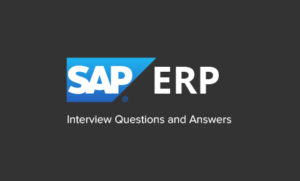SAP FICO Interview Questions
SAP (originally System Applications and Products in Data Processing) remains a major player in enterprise software in 2024. Here’s a quick rundown:
- Focus on Growth Areas: SAP is emphasizing key areas like Business AI to help businesses leverage data and automation.
- Transformation Program: They’re undergoing a company-wide restructuring in 2024 to improve efficiency and scalability for future growth.
- Continued Demand: SAP’s ERP (Enterprise Resource Planning) software suite and integrated solutions are still widely used across various industries.
Introduction to SAP FICO
SAP FICO is a module within the broader SAP ERP suite that specifically handles financial accounting (FI) and controlling (CO).
- Financial Accounting (FI): Manages core financial transactions like accounts payable/receivable, general ledger, and fixed assets.
- Controlling (CO): Focuses on internal cost management, profitability analysis, and budgeting.
Benefits of SAP FICO:
- Streamlines financial processes and reporting.
- Improves financial transparency and control.
- Enables better decision-making with real-time data.
Who uses SAP FICO?
Finance professionals like accountants, controllers, and financial analysts heavily rely on SAP FICO for their daily tasks.
Also, Review our previous updates on SAP FICO interview questions and answers for fresher candidates, divided into Part 1 and Part 2.
SAP FICO Interview Questions PART-1
SAP FICO Interview Questions PART-2
Check both parts for comprehensive coverage of essential interview topics.
SAP FICO Interview Questions and Answers for Experienced
Question: What is the primary purpose of the SAP FICO?
Answer: The primary purpose of SAP FICO (Finance and Controlling) is to streamline financial management processes within organizations. It integrates financial accounting and controlling modules to automate transactions, support real-time reporting, facilitate internal and external financial reporting, and enable effective decision-making for improved overall financial control and transparency.
Question: What is the role of the Financial Accounting (FI) module in SAP FICO?
Answer: The FI module in SAP FICO manages financial transactions, external reporting, general ledger accounting, accounts payable, accounts receivable, asset accounting, and other financial processes.
Question: What functions does the Controlling (CO) module in SAP FICO perform?
Answer: The CO module handles internal reporting and management accounting. It includes cost accounting, profit center accounting, internal orders, and product costing to help organizations control and monitor their costs.
Question: Explain the Chart of Accounts in SAP FICO?
Answer: The chart of accounts in SAP FICO is a structured list of all general ledger (GL) accounts used by a company. It organizes financial transaction data and provides a framework for recording, classifying, and summarizing financial information. The chart of accounts typically includes balance sheet and profit and loss statement accounts, each assigned a unique identifier and defined by its properties such as account group, type, and description.
Question: Explain the concept of a tax line item in SAP FICO?
Answer: A tax line item in SAP FICO represents the tax amount associated with a financial transaction. It is a separate line item within the accounting document that indicates the tax calculated on the transaction. This line item is essential for accurate tax reporting, compliance, and analysis of financial data.
Question: Describe document splitting in SAP FICO?
Answer: Document splitting in SAP FICO is a feature that allows the system to split financial transactions into multiple line items based on defined criteria. It enables detailed reporting and analysis by segmenting transactions according to various dimensions such as profit centers, business areas, or functional areas. Document splitting ensures accurate allocation of costs and revenues across different organizational units or segments.
Question: Explain Zero Balance Clearing? Provide an example of zero balance clearing in SAP FICO?
Answer: Zero balance clearing in SAP FICO refers to the process of reconciling open items in accounts to ensure that the net balance is zero. It involves offsetting debits and credits by applying payments or clearing transactions. This helps maintain accurate financial records, simplifies reconciliation, and ensures that outstanding items are appropriately matched, reducing discrepancies in financial reporting.
An example of zero balance clearing in SAP FICO involves reconciling open items in customer accounts. Suppose a customer has made partial payments against multiple invoices. Zero balance clearing helps match the payments with the respective invoices, ensuring that the customer account balance becomes zero once all outstanding invoices are settled.
Question: In SAP FICO, how is the sequence of accounts maintained in the general ledger?
Answer: The general ledger in SAP FICO follows a structured order of accounts. This sequence typically begins with balance sheet accounts like assets and liabilities, followed by revenue and expense accounts. Within each category, accounts are organized based on their nature and function. For example, under assets, you may find sub-accounts for cash, receivables, and fixed assets. This systematic arrangement ensures a logical flow of financial information, making it easier for organizations to track and report their financial activities accurately within the SAP FICO system.
Question: How does SAP FICO integrate customer and vendor functionalities within its system?
Answer: In SAP FICO, the integration of customer and vendor data involves linking customer and vendor master records to facilitate streamlined business processes. By defining customers and vendors as parameters, organizations can share common data such as addresses, contact details, and payment terms, thereby improving efficiency and accuracy in financial transactions.
Question: Have you worked with parallel ledger and accounts in SAP FICO?
Answer: Yes, I have worked with parallel ledgers and accounts in SAP FICO. Parallel ledgers allow companies to maintain multiple accounting principles or reporting currencies simultaneously. Each parallel ledger has its own set of accounts, enabling parallel reporting in different currencies or according to different accounting standards.
Question: What are the document systems you would run on F10 in SAP FICO?
Answer: In SAP FICO, when you use the F10 function key, it typically corresponds to the “Document Overview” or “Document Display” functionality. The specific document systems you can run with F10 depend on the context within SAP.
Here are some common document systems you might access using F10 in SAP FICO:
- Document Overview (FB03)
- Document Display (FB03)
- Park Document Display (FBV3)
- Vendor Document Display (FK03)
- Customer Document Display (FD03)
Question: What is an overview of Accounts Payable (AP) in SAP FICO, and what are the steps involved in configuring AP at all company code levels?
Answer: Accounts Payable (AP) in SAP FICO manages an organization’s outgoing payments to vendors and suppliers. The process involves receiving invoices, verifying them against purchase orders and goods receipts, and making payments within agreed terms.
Configure Accounts Payable settings in SAP FICO by following these steps uniformly across all company codes:
Define Company Codes: Set up company codes in SAP.
Assign Company Code to Chart of Accounts: Link each company code to a specific chart of accounts.
Define Tolerance Groups: Establish tolerance limits for payment differences.
Create Vendor Master Data: Input vendor details, including payment terms and reconciliation accounts.
Define Document Number Ranges: Specify ranges for document numbers in AP transactions.
Set Up Automatic Payment Programs: Configure parameters for automated payment processing.
Define House Banks: Specify banks for outgoing payments.
Configure Tax on Sales/Purchases: Define tax codes for accurate tax calculations.
Maintain Payment Terms: Set terms for payment due dates.
Activate Document Splitting: If required, activate document splitting for detailed financial reporting.
Question: Which house bank is permissible in SAP FICO?
Answer: In SAP FICO, the choice of a permissible house bank depends on the specific requirements and agreements of the organization. Typically, any bank where the company holds accounts and conducts financial transactions can be set up as a house bank in SAP FICO. The configuration involves defining the house bank, its accounts, and relevant details to facilitate various financial transactions within the system.
Question: List the five formats you have worked with in Electronic Bank Statement (EBS) processing.
Answer: In Electronic Bank Statement processing, I have worked with various formats, including BAI2 (Bank Administration Institute), MT940 (SWIFT), CAMT.053 (ISO 20022), CSV (Comma-Separated Values), and IDoc (Intermediate Document). Each format serves as a standardized way for banks to provide electronic statements, facilitating automatic reconciliation of bank transactions in SAP.
Question: What are the various types of external transactions in SAP FICO? and how the system determines whether they belong to ongoing payments or incoming payments?
Answer: In SAP FICO, external transactions encompass a range of financial activities involving entities outside the organization. Some key types include:
Customer Transactions:
Involves sales, accounts receivable, and customer payments.
Vendor Transactions:
Encompasses procurement, accounts payable, and vendor payments.
Bank Transactions:
Covers activities such as cash deposits, withdrawals, and reconciliations.
Asset Transactions:
Involves the acquisition, depreciation, and disposal of assets.
Tax Transactions:
Includes tax calculations, deductions, and payments to tax authorities.
Intercompany Transactions:
Deals with financial interactions between different entities within the same organization.
Loan and Financing Transactions:
Encompasses loans, interest payments, and other financing activities.
Foreign Currency Transactions:
Involves transactions conducted in currencies other than the local currency.
Expense Transactions:
Covers various operational expenses incurred by the organization.
Revenue Transactions:
Encompasses all forms of income generated by the organization.
The system determines whether a transaction belongs to ongoing payments or incoming payments based on the nature of the transaction code and associated business rules. For example, payment codes might be classified as outgoing transactions, while receipt codes are considered incoming transactions.
Question: Describe the Fixed Deposit integration process in SAP FICO?
Answer: In SAP FICO, the integration process for Fixed Deposit typically involves several steps:
Creation of Fixed Deposit Master Data:
Define fixed deposit details such as bank, interest rates, and maturity periods.
Transaction Entry:
Record the fixed deposit transaction, specifying the amount, date, and relevant details.
Journal Entries:
SAP FICO generates accounting entries, crediting the bank and debiting the fixed deposit account.
Interest Accruals:
Automated accrual of interest based on defined terms, reflecting in financial statements.
Maturity and Redemption:
Upon maturity, SAP FICO automates the redemption process, updating financial records.
Integration with Asset Accounting:
Optionally link fixed deposits to asset accounting for comprehensive financial tracking.
Reporting:
Access real-time reports for fixed deposit status, interest accruals, and overall financial position.
Question: Discuss the various types of documents posting in SAP FICO?
Answer: In SAP FICO, various types of document postings cater to different financial transactions. Common types include:
Journal Entry (FB50): Records single transactions affecting one account.
Park Document (FV50): Temporarily stores incomplete documents before posting.
Accrual/Deferral (FBS1): Adjusts accounting periods for expenses or revenues.
Vendor Invoice Posting (FB60): Records incoming invoices.
Customer Invoice Posting (FB70): Documents outgoing invoices.
Asset Acquisition (F-90): Captures the acquisition of fixed assets.
Bank Posting (F-01): Registers bank-related transactions.
Payment Entry (F-53): Records outgoing payments.
Question: What steps are included in asset creation in SAP FICO?
Answer: Asset creation in SAP FICO involves several steps:
Asset Master Data: Create an asset master record with details such as asset class, depreciation areas, and useful life.
Asset Acquisition: Record the acquisition of the asset through purchase or internal transfer.
Depreciation: Configure depreciation keys and areas for calculating periodic depreciation.
Asset Retirement: Manage the retirement or disposal of assets, recording gains or losses.
Depreciation Run: Execute periodic runs to calculate and post depreciation.
These steps ensure proper management, tracking, and accounting for fixed assets in the SAP FICO system.
Question: Describe the Automatic Payment Program in SAP FICO?
Answer: The Automatic Payment Program (APP) in SAP FICO automates the payment process. It allows the creation and execution of payment runs based on defined selection criteria. The program considers due dates, discounts, and payment methods to generate payment documents. APP streamlines the payment process, reducing manual effort and ensuring timely payments.
Question: What are the types of reports available in SAP FICO?
Answer: Types of reports in SAP FICO include:
- Financial Statements: Balance Sheet, Profit and Loss Statement.
- Accounts Receivable and Payable Reports.
- Asset Accounting Reports.
- Controlling Reports: Cost Center Reports, Profit Center Reports.
- Tax Reports: Withholding Tax Reports, Tax Declarations.
- Cash Flow Reports: Statement of Cash Flows.
Question: Explain the Procure-to-Pay (P2P) cycle with a focus on down payment and FM integration in SAP FICO.
Answer: The Procure-to-Pay (P2P) cycle in SAP FICO involves the entire procurement process, from requisitioning goods or services to making payments to vendors. When focusing on down payments and Fund Management (FM) integration, the cycle begins with a purchase requisition triggering a purchase order. Once the goods or services are delivered, a down payment request may be initiated, reflecting a partial payment to the vendor. In SAP FICO, this down payment triggers accounting entries, updating both accounts payable and the general ledger.
Integration with Fund Management ensures budget availability before processing the down payment. Funds are reserved during the purchase requisition phase, preventing overspending. Upon successful goods receipt and invoice verification, the down payment is cleared against the final invoice. This comprehensive integration in SAP FICO ensures transparency, financial control, and adherence to budgetary constraints throughout the P2P cycle.
Question: How do you address withholding tax system errors in SAP FICO?
Answer: To address withholding tax system errors in SAP FICO, the user should first identify the nature of the error. Common corrective actions include reviewing and adjusting tax codes, verifying vendor or customer master data, and ensuring that the withholding tax configuration is accurate. Additionally, monitoring tax codes during document entry and executing relevant reports for reconciliation can help identify and rectify withholding tax errors.
Question: Explain the concept of accounts determination in SAP FICO.
Answer: Accounts determination in SAP FICO is the process of assigning GL accounts to various business transactions. This configuration ensures that the correct accounts are used when posting financial transactions. It involves defining account keys, which link to specific GL accounts based on the transaction type, business area, or other criteria. This mapping ensures accurate and consistent accounting treatment for different types of transactions.
Question: What are the different types of depreciation methods, depreciation calculation methods, and CL methods in SAP FICO?
Answer: In SAP FICO, there are various types of depreciation methods, depreciation calculation methods, and asset value adjustment methods. Here’s a breakdown:
Depreciation Methods:
- Straight-Line Depreciation (SL): Allocates an equal amount of depreciation expense each accounting period.
- Declining Balance Method (WDV): Calculates depreciation based on the book value of the asset, applying a fixed percentage to the remaining value.
- Units of Production (UOP): Depreciates assets based on the actual usage or production output.
Depreciation Calculation Methods:
- Time-Based: Calculates depreciation over a specific time period (e.g., years, months).
- Period Control Method: Defines when depreciation is posted during the fiscal year.
- Balancing Field Method: Assigns balancing fields for certain depreciation areas.
Capitalization or Adjustment (CL) Methods:
- Manual Capitalization (M): Allows manual adjustment of values for capitalized costs.
- Revenue Distribution (R): Allocates revenues to different company codes or segments.
Question: Explain special general ledger transactions in SAP FICO.
Answer: Special General Ledger transactions in SAP FICO are used to manage specific business scenarios outside the regular General Ledger processing. These transactions include items such as down payments, bill of exchange, and guarantees. For example, when a customer makes a down payment, a special General Ledger account is used to track and manage this prepayment. Configuring these transactions allows organizations to handle unique financial scenarios efficiently and ensures accurate reporting in line with standard accounting principles.
Question: Enumerate the types of cost elements in SAP FICO.
Answer: SAP FICO includes various types of cost elements that categorize expenses and revenues. The main types are:
Primary Cost Elements: Directly associated with GL accounts and used in cost accounting.
Secondary Cost Elements: Indirectly linked and used for internal allocations or assessments.
Revenue Cost Elements: Represent income generated from sales or services.
Statistical Cost Elements: Used for statistical purposes, not impacting financial accounting.
These cost elements play a crucial role in cost tracking, allocation, and reporting within the SAP FICO system.
Question: How do you handle foreign currency transactions in SAP FICO?
Answer: SAP FICO handles foreign currency transactions through the use of parallel currencies and currency keys. Companies can define local and global currencies, allowing transactions to be recorded and reported in multiple currencies simultaneously. Exchange rate types and translation methods are configured to manage currency conversions accurately. Foreign currency valuation ensures that balance sheet items are revalued at the current exchange rates, maintaining accurate financial reporting in the company’s chosen reporting currency.
Question: Outline the steps involved in accounts receivable and accounts payable processes in SAP FICO.
Answer: The accounts receivable process in SAP FICO involves:
- Customer master data creation.
- Sales order processing and invoicing.
- Receipt of customer payments and reconciliation.
- The accounts payable process includes:
- Vendor master data creation.
- Purchase order and goods receipt processing.
- Invoice verification and payment processing.
- Reconciliation of vendor accounts.
- These processes ensure accurate recording and management of financial transactions with customers and vendors.




